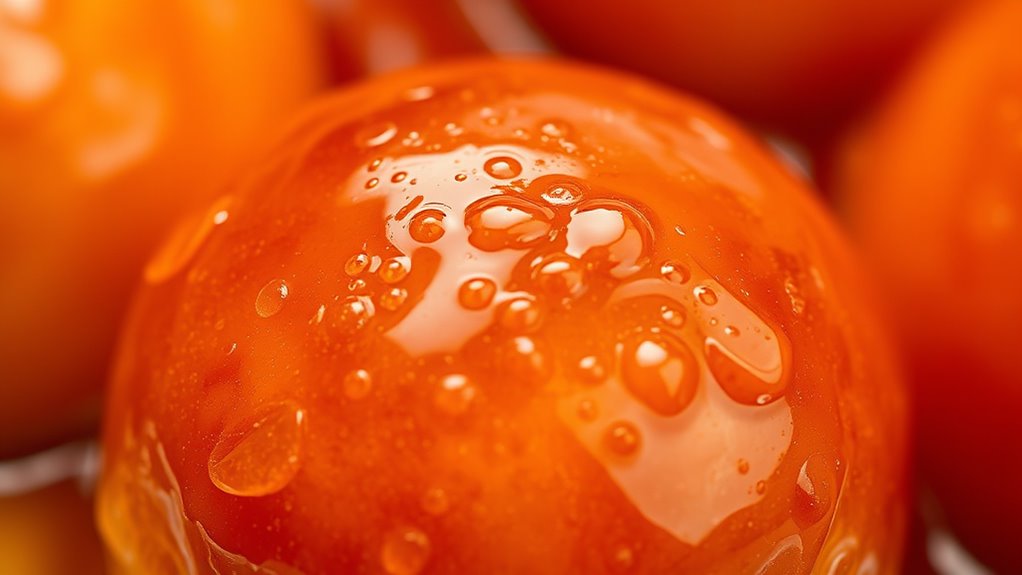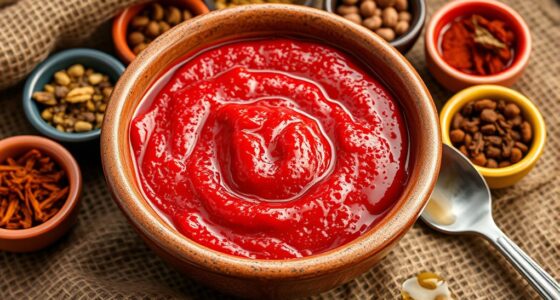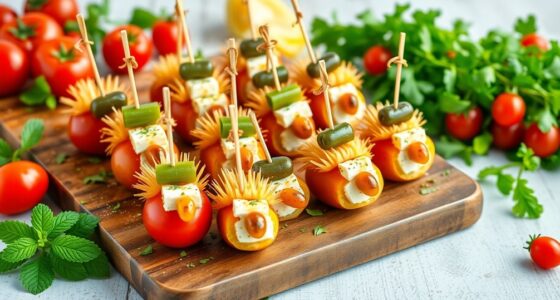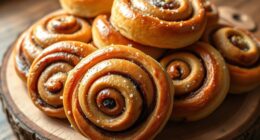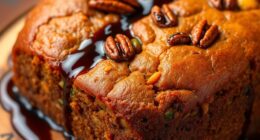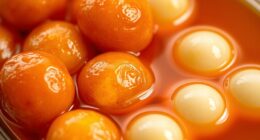To master Gulab Jamun’s syrup, you need to understand how sugar, water, and spices create the perfect consistency. The syrup should be warm and slightly thick, which helps it soak into the soft, fried balls. Proper temperature control during soaking opens the pores, allowing syrup to penetrate fully. Using aromatic additions like cardamom or rose water enhances flavor. Keep exploring to learn more about achieving that ideal, melt-in-your-mouth finish.
Key Takeaways
- The syrup’s temperature and viscosity are crucial for proper absorption and achieving the desired tender, melt-in-your-mouth texture.
- Infusing syrup with spices like cardamom and rose water enhances aroma and flavor, creating a harmonious balance.
- Proper sugar concentration and consistent simmering ensure the syrup is thick enough to coat and penetrate the Gulab Jamun.
- Soaking hot Gulab Jamun in warm syrup allows better pore opening for absorption, resulting in juicy, flavorful balls.
- Precise control of syrup temperature and soaking time ensures optimal flavor infusion and prevents sogginess or dryness.
The Origin and Significance of Gulab Jamun Syrup

The syrup in Gulab Jamun is more than just a sweet addition; it holds deep cultural and historical significance. Originating in Persia and spreading through India, the syrup reflects centuries-old culinary traditions. Historically, it symbolized hospitality and celebration, often served during festivals and special occasions. Culinary evolution shows how regional ingredients and techniques have shaped this iconic dessert. The fragrant rosewater and cardamom-infused syrup elevate the dessert, connecting it to regional customs. In Indian culture, sharing Gulab Jamun signifies warmth and togetherness. The syrup’s rich history underscores its role beyond taste, representing cultural identity and heritage. When you enjoy Gulab Jamun, you’re partaking in a tradition that has been cherished for generations, embodying hospitality, festivity, and the timeless art of flavor blending. Additionally, understanding the benefits of curiosity can deepen appreciation for exploring culinary traditions and their cultural roots. Exploring traditional recipes can reveal the intricate techniques passed down through generations, enriching your appreciation for the dessert’s significance.
Key Ingredients That Define the Syrup’s Composition

A few simple ingredients come together to create the distinctive and aromatic syrup that elevates Gulab Jamun. The key components are essential for its flavor and texture. First, sugar provides the sweetness and body needed for soaking the soft balls. Second, water dissolves the sugar and forms the base of the syrup, ensuring it’s smooth and pourable. Third, aromatic spices like cardamom or rose water add depth and fragrance, making each bite memorable. These ingredients are carefully balanced to achieve the perfect syrup consistency—thick enough to cling but not overpowering. When combined, they create a harmonious blend that infuses the Gulab Jamun with its signature sweetness and floral aroma, making it a beloved dessert across India.
The Role of Sugar and Ghee in Achieving the Perfect Texture

You need to get the right sugar concentration balance to guarantee your gulab jamuns are neither too chewy nor too firm. Ghee plays a vital role in making the texture soft and melt-in-your-mouth. Adjusting both ingredients carefully will help you achieve that perfect, tender bite every time. Proper use of high-efficiency ingredients can also contribute to a more consistent and desirable texture.
Sugar Concentration Balance
Have you ever wondered how the right balance of sugar and ghee makes Gulab Jamun irresistibly tender and melt-in-your-mouth? Achieving this perfect texture depends on controlling sugar concentration in the syrup. Here’s what you need to keep in mind:
- Optimal Sugar Ratio: Use just enough sugar to create a sweet, sticky syrup without overpowering the jamun’s softness.
- Proper Dissolution: Ensure the sugar dissolves completely to avoid graininess and create a smooth, cohesive syrup.
- Syrup Temperature: Keep the syrup warm during soaking; this helps the jamuns absorb syrup evenly, enhancing tenderness.
Balancing sugar concentration is vital for that ideal, luscious melt-in-your-mouth experience.
Ghee’s Impact on Softness
Ghee plays a crucial role in creating Gulab Jamun’s signature softness, working synergistically with sugar to achieve the perfect melt-in-your-mouth texture. When you incorporate ghee into the dough, it coats the flour particles, preventing excessive gluten formation and resulting in a tender, crumbly bite. Ghee also helps the dough stay moist and pliable, making shaping easier. During frying, ghee’s high smoke point ensures even cooking without drying out the balls. Its richness contributes to a luxurious mouthfeel, balancing the sweetness of the syrup. By using ghee, you guarantee that each bite remains soft and juicy, enhancing the overall experience. The right amount of ghee, combined with sugar, is essential to mastering that perfect, melt-in-your-mouth Gulab Jamun. Proper ingredient balance ensures optimal texture and flavor in the final treat.
How Temperature Influences the Syrup’s Consistency

Temperature plays a crucial role in determining the consistency of gulab jamun syrup. When the syrup is too hot, it becomes thin and runny, making it hard for the gulab jamun to soak properly. As it cools, the syrup thickens, allowing better absorption. To get the perfect consistency, keep these points in mind:
- Heat level: Maintain a gentle simmer to avoid overly thin or thick syrup.
- Cooling process: Let the syrup cool slightly before soaking, ensuring it’s thick enough but still fluid.
- Storage temperature: Refrigeration cools the syrup further, increasing viscosity and making it more challenging to soak into the jamuns. Proper temperature regulation is also essential to prevent over-thickening that can hinder absorption.
- Consistency control: Using a thermometer can help monitor the syrup’s temperature precisely, ensuring optimal viscosity. Implementing precise temperature control can also help maintain the desired syrup consistency, resulting in perfectly soaked gulab jamuns. Additionally, understanding how Glycolic Acid Benefits contribute to skin radiance and texture can inform other culinary or skincare practices involving controlled exfoliation and surface treatment. Controlling temperature ensures your gulab jamun’s syrup hits that ideal, sticky-sweet balance.
The Chemistry Behind Soaking and Absorption

The process of soaking gulab jamuns involves more than just immersing them in syrup; it’s governed by fundamental principles of chemistry that determine how the syrup penetrates the soft interior of each piece. When you submerge the jamuns, osmotic pressure drives the syrup into their porous structure. The sugar molecules and the syrup’s viscosity influence how quickly and deeply absorption occurs. Temperature plays a crucial role, affecting both the syrup’s flow and the jamun’s firmness. As the syrup moves inward, it interacts with the starch and milk solids, gradually replacing the moisture inside the dough. Osmotic pressure is a key factor in how effectively the syrup is absorbed, ensuring the jamuns are evenly soaked. Proper noise reduction technology in heat pumps ensures quieter operation, which can make the soaking process more pleasant in the kitchen environment. Additionally, the porous structure of the gulab jamun plays a vital role in how well the syrup can penetrate. Introducing controlled temperature during soaking can optimize absorption efficiency and texture. Furthermore, understanding the chemical interactions involved can help you achieve a more consistent and flavorful result. This absorption creates the characteristic juicy, sweet interior you enjoy. Understanding these chemical interactions helps you perfect the soaking process for consistently delicious gulab jamuns.
The Impact of Flavored Additions and Aromatics

Adding flavored ingredients and aromatics to gulab jamun syrup enhances their aroma and taste, transforming a simple dessert into a multisensory experience. You can elevate the flavor profile in several ways:
Enhance gulab jamun syrup with aromatics like cardamom, rose water, or saffron for richer flavor and aroma.
- Infuse the syrup with cardamom pods, which add a warm, spicy aroma that complements the sweetness.
- Add rose water or saffron strands for a floral or luxurious touch that deepens the syrup’s complexity.
- Incorporate a hint of kewra or orange blossom water to introduce fresh, fragrant notes.
- Incorporate natural materials like dried herbs or zest to enhance the aromatic layers and deepen the flavor profile.
- Using aromatic spices such as cinnamon or star anise can further add depth and warmth to the syrup.
- Incorporating essential oils derived from herbs or flowers can intensify the aroma and add unique flavor nuances.
These additions don’t just improve aroma—they also balance the sweetness and create a layered, memorable flavor. By choosing specific aromatics, you tailor the gulab jamun’s sensory profile to match your preferences.
Techniques for Achieving the Ideal Syrup-Soaked Effect

To get that perfect syrup-soaked Gulab Jamun, you need the right syrup consistency—thick enough to cling but not so heavy that it doesn’t absorb. Timing is vital; you should warm the syrup and soak the fried balls while they’re still hot. This ensures they soak up the syrup evenly and achieve that melt-in-your-mouth texture.
Proper Syrup Consistency
Have you ever wondered how to get the perfect syrup consistency for gulab jamun? Achieving the right thickness ensures the sweets soak evenly without becoming soggy. To do this:
- Keep the syrup slightly thicker than honey; it should flow but coat the back of a spoon.
- Simmer the syrup gently to avoid thinness, and avoid stirring too much to prevent crystallization.
- Test the consistency by dipping a spoon—if the syrup coats it smoothly and slowly drips off, you’re there.
- Maintaining the correct temperature during simmering helps achieve optimal viscosity and prevents the syrup from becoming too thin or too thick.
Timing for Absorption
Once you’ve achieved the perfect syrup consistency, timing becomes key to ensuring your gulab jamun absorbs just the right amount of syrup. You should immerse the fried balls while they’re still warm, as heat helps open their pores, allowing better absorption. Let them soak for at least 30 minutes to an hour; longer soaking results in a softer, juicier texture. Avoid soaking too long, which can make the jamuns overly soggy or break apart. To improve absorption, gently rotate the balls in syrup during soaking, ensuring even coverage. If the syrup cools and thickens, gently warm it again to maintain ideal soaking conditions. Proper timing guarantees your gulab jamun achieves that perfect balance of syrup-soaked sweetness and tender bite. Additionally, maintaining the correct temperature of the syrup is crucial for optimal absorption and texture. To further enhance the process, ensure the syrup is at the right consistency for soaking, which can be checked by how it coats the back of a spoon.
Common Mistakes and How to Avoid Them

Even experienced cooks can stumble into common mistakes when making gulab jamun, but recognizing these pitfalls can safeguard your time and ensure perfect results. First, avoid overmixing the dough, which can make the jamuns dense and tough. Mix just until the ingredients come together. Second, don’t fry the balls at too high a temperature; this causes uneven cooking and cracks. Maintain a steady, medium heat for even browning. Third, don’t skip soaking the jamuns long enough; they need time to absorb syrup fully. Let them sit for at least 2 hours after frying. Paying attention to these details helps you achieve soft, syrup-soaked gulab jamuns with a perfect, melt-in-your-mouth texture. Additionally, cultivating a creative practice of experimenting with different techniques can help you develop custom methods for perfecting your gulab jamuns over time. Incorporating efficient general ledger coding into your recipe management or record-keeping can further streamline your kitchen organization and improve your overall cooking process. Proper oil selection and maintaining the right frying temperature can also enhance the texture and appearance of your gulab jamuns.
The Science of Texture and Flavor Integration

How do the textures and flavors in gulab jamun come together to create that irresistible dessert? It’s all about harmony. The soft, spongy interior of the fried dough absorbs the warm, fragrant syrup, creating a melt-in-your-mouth experience. The slight chewiness of the dough contrasts beautifully with the sticky syrup, enhancing each bite. Flavor-wise, the sweetness of the syrup balances the richness of the milk solids, while hints of cardamom and rose water add aromatic depth. You want these elements to blend seamlessly so that no single flavor overwhelms the others. The key is controlling the syrup’s temperature and soaking time, ensuring the jamuns soak up just enough syrup to become juicy without turning soggy. This balance is what makes gulab jamun a truly delightful, cohesive treat.
Frequently Asked Questions
How Does the Ph Level Affect Gulab Jamun Syrup Absorption?
You might wonder how pH levels influence syrup absorption in gulab jamun. When the syrup’s pH is more acidic, it enhances the jamun’s ability to absorb the syrup, making it juicy and flavorful. Conversely, a higher pH (more alkaline) can hinder absorption, resulting in a less soaked texture. Adjusting the syrup’s pH guarantees the perfect balance, giving you moist, delicious gulab jamuns every time.
What Role Does Viscosity Play in Syrup Consistency?
Viscosity acts like the heartbeat of your syrup, controlling its flow and texture. When syrup is thick, it clings better to the jamun, soaking in flavors deeply. If it’s too thin, it drips and leaves the fruit dry. Think of viscosity as the rhythm that keeps your gulab jamun tender and juicy, ensuring each bite is a perfect balance of syrup and soft sponginess.
Can Different Types of Sugar Alter the Syrup’s Flavor Profile?
You might wonder if different sugars change the syrup’s flavor. Yes, they do. Using white sugar gives a neutral, sweet taste, while brown sugar adds caramel notes. Honey or jaggery can introduce unique flavors and aromas. The type of sugar affects not only flavor but also the syrup’s texture and color. So, experimenting with sugars lets you customize the taste to your liking.
How Does Humidity Impact Syrup Preparation and Storage?
Humidity affects syrup preparation and storage considerably. When humidity is high, you might find it harder to boil the syrup to the right consistency because moisture in the air can dilute the sugar concentration. During storage, excess moisture can cause the syrup to spoil or ferment faster. To manage this, you should keep your syrup in airtight containers and store it in a cool, dry place to maintain its quality.
What Are the Effects of Adding Natural Versus Artificial Flavorings?
Think of flavorings as the spice to your culinary adventure. When you add natural flavorings, you get a richer, more authentic taste that evolves with time. Artificial flavorings, on the other hand, provide a more consistent and intense flavor but may lack depth. Your choice influences not just the flavor but also the aroma and shelf life. So, pick wisely to craft the perfect syrup that sings with your desired notes.
Conclusion
Understanding the science behind gulab jamun syrup reveals how simple ingredients create complex flavors. Like a delicate dance between sweetness and aroma, perfect syrup balances chemistry and technique. It’s the contrast between sticky and smooth, warm and fragrant, that makes each bite memorable. When you master these details, you don’t just make dessert—you craft a symphony of flavor and texture, turning a humble treat into an unforgettable experience.
